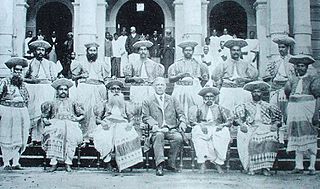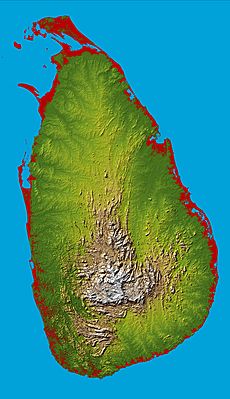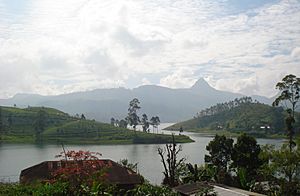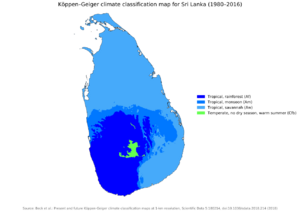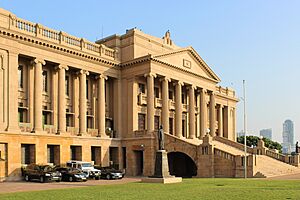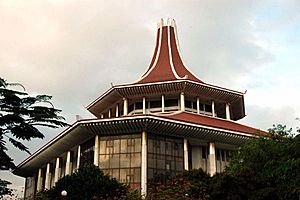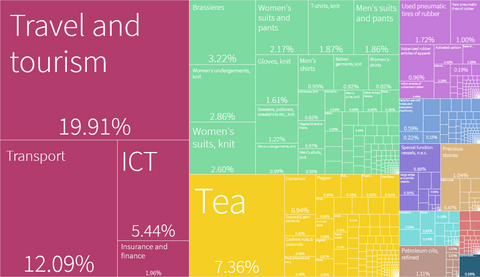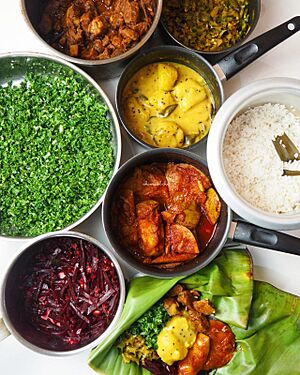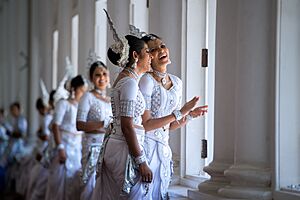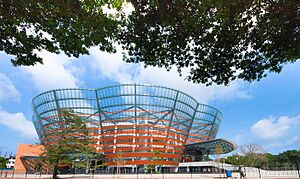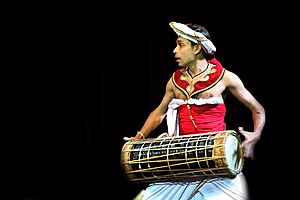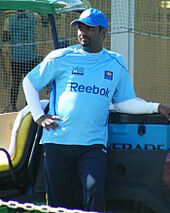Sri Lanka facts for kids
Quick facts for kids
Democratic Socialist Republic of
Sri Lanka |
|
|---|---|
|
|
|
|
Anthem: "Sri Lanka Matha"
ශ්රී ලංකා මාතා (Sinhala) ஸ்ரீ லங்கா தாயே (Tamil) (English: "Mother Sri Lanka") |
|
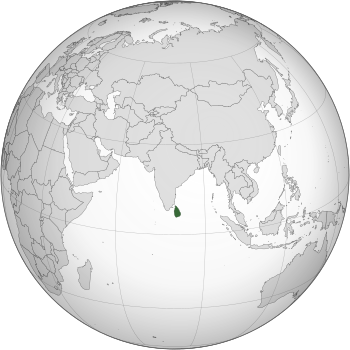 |
|
| Capital |
|
| Largest city | Colombo |
| Official languages | |
| Recognised language | English |
| Ethnic groups
(2012)
|
|
| Religion
(2012)
|
70.2% Buddhism (official) 12.6% Hinduism 9.7% Islam 7.4% Christianity 0.1% other / none |
| Demonym(s) | Sri Lankan |
| Government | Unitary semi-presidential republic |
| Anura Kumara Dissanayake | |
| Harini Amarasuriya | |
|
• Speaker of the Parliament
|
Ashoka Ranwala |
| Legislature | Parliament |
| Formation | |
|
• Kingdom established
|
543 BCE |
|
• Anuradhapura period
|
377 BCE–1017 CE |
|
• Polonnaruwa period
|
1017–1232 |
|
• Transitional period
|
1232–1592 |
|
• Kandyan period
|
1592–1815 |
|
• British Ceylon period
|
1815–1948 |
|
• Independence
|
4 February 1948 |
|
• Republic
|
22 May 1972 |
|
• Current constitution
|
7 September 1978 |
| Area | |
|
• Total
|
65,610.2 km2 (25,332.2 sq mi) (120th) |
|
• Water (%)
|
4.4 |
| Population | |
|
• 2022 estimate
|
|
|
• 2012 census
|
20,277,600 |
|
• Density
|
337.7/km2 (874.6/sq mi) (43rd) |
| GDP (PPP) | 2023 estimate |
|
• Total
|
|
|
• Per capita
|
|
| GDP (nominal) | 2023 estimate |
|
• Total
|
|
|
• Per capita
|
|
| Gini (2016) | 39.8 medium |
| HDI (2022) | high · 78th |
| Currency | Sri Lankan rupee (Rs) (LKR) |
| Time zone | UTC+5:30 (SLST) |
| Driving side | left |
| Calling code | +94 |
| ISO 3166 code | LK |
| Internet TLD |
|
The Democratic Socialist Republic of Sri Lanka (in Sinhala in Tamil) is a tropical island nation off the southeast coast of the Indian subcontinent. The capital of the country is Sri Jayawardanapura while the largest city is Colombo.
It was known as Ceylon before 1972, and Serendib and Sinhale, among other names, before that. It was South Asia's oldest democracy.
Contents
History
Sri Lanka's documented history goes back 3,000 years, with evidence of prehistoric human settlements dating back 125,000 years. The earliest known Buddhist writings of Sri Lanka, known collectively as the Pali Canon, date to the fourth Buddhist council, which took place in 29 BCE. Also called the Pearl of the Indian Ocean, or the Granary of the East, Sri Lanka's geographic location and deep harbours have made it of great strategic importance, from the earliest days of the ancient Silk Road trade route to today's so-called maritime Silk Road. Because its location made it a major trading hub, it was already known to both East Asians and Europeans as long ago as the Anuradhapura period. During a period of great political crisis in the Kingdom of Kotte, the Portuguese arrived in Sri Lanka and sought to control its maritime trade, with a part of Sri Lanka subsequently becoming a Portuguese possession. After the Sinhalese-Portuguese war, the Dutch colonial empire and the Kingdom of Kandy took control of those areas. Dutch Ceylon was taken by the British Empire, which extended control over the whole island, colonising it as British Ceylon from 1815 to 1948. A national movement for political independence arose in the early 20th century, and 1948, Ceylon became a dominion. It was succeeded by the republic of Sri Lanka in 1972. Sri Lanka's more recent history was marred by the 26-year Sri Lankan Civil War, which began in 1983 and ended in 2009, when the Sri Lanka Armed Forces defeated the Liberation Tigers of Tamil Eelam.
Ethnic make-up
Sri Lanka has three main ethnic groups. They differ in their religions and origins, and there has often been difficulties between the groups. The total population of the island is over 20 million people, and rapidly expanding.
The largest of the three groups is the population of Sinhalese people, most of whom are Buddhist, and who have their own language, Sinhala. They make up about 75% of the population.
The second largest group is the Tamil people, who are Hindu. There are about 2,271,000 Tamils in Sri Lanka.
The third largest group is the Sri Lankan Moors, who are Muslim. There are over one and a half million people in this group. They use Tamil as their language today.
There are a number of smaller ethnic groups, of which the Veddas are notable because they may be the original inhabitants of the island, or at any rate the earliest to survive today. They have "indigenous people" status in the island.
Provinces
Sri Lanka has 9 provinces.
Geography
Sri Lanka, an island in South Asia shaped as a teardrop or a pear/mango, lies on the Indian Plate, a major tectonic plate that was formerly part of the Indo-Australian Plate. It is in the Indian Ocean southwest of the Bay of Bengal, between latitudes 5° and 10° N, and longitudes 79° and 82° E. Sri Lanka is separated from the mainland portion of the Indian subcontinent by the Gulf of Mannar and Palk Strait. According to Hindu mythology, a land bridge existed between the Indian mainland and Sri Lanka. It now amounts to only a chain of limestone shoals remaining above sea level. Legends claim that it was passable on foot up to 1480 CE, until cyclones deepened the channel. Portions are still as shallow as 1 metre (3 ft), hindering navigation. The island consists mostly of flat to rolling coastal plains, with mountains rising only in the south-central part. The highest point is Pidurutalagala, reaching 2,524 metres (8,281 ft) above sea level.
Sri Lanka has 103 rivers. The longest of these is the Mahaweli River, extending 335 kilometres (208 mi). These waterways give rise to 51 natural waterfalls of 10 metres (33 ft) or more. The highest is Bambarakanda Falls, with a height of 263 metres (863 ft). Sri Lanka's coastline is 1,585 km (985 mi) long. Sri Lanka claims an exclusive economic zone extending 200 nautical miles, which is approximately 6.7 times Sri Lanka's land area. The coastline and adjacent waters support highly productive marine ecosystems such as fringing coral reefs and shallow beds of coastal and estuarine seagrasses.
Sri Lanka has 45 estuaries and 40 lagoons. Sri Lanka's mangrove ecosystem spans over 7,000 hectares and played a vital role in buffering the force of the waves in the 2004 Indian Ocean tsunami. The island is rich in minerals such as ilmenite, feldspar, graphite, silica, kaolin, mica and thorium. Existence of petroleum and gas in the Gulf of Mannar has also been confirmed, and the extraction of recoverable quantities is underway.
Climate
The climate is tropical and warm because of moderating effects of ocean winds. Mean temperatures range from 17 °C (62.6 °F) in the central highlands, where frost may occur for several days in the winter, to a maximum of 33 °C (91.4 °F) in low-altitude areas. Average yearly temperatures range from 28 °C (82.4 °F) to nearly 31 °C (87.8 °F). Day and night temperatures may vary by 14 °C (57.2 °F) to 18 °C (64.4 °F).
The rainfall pattern is influenced by monsoon winds from the Indian Ocean and Bay of Bengal. The "wet zone" and some of the windward slopes of the central highlands receive up to 2,500 millimetres (98.4 in) of rain each year, but the leeward slopes in the east and northeast receive little rain. Most of the east, southeast, and northern parts of Sri Lanka constitute the "dry zone", which receives between 1,200 and 1,900 mm (47 and 75 in) of rain annually.
The arid northwest and southeast coasts receive the least rain at 800 to 1,200 mm (31 to 47 in) per year. Periodic squalls occur and sometimes tropical cyclones bring overcast skies and rains to the southwest, northeast, and eastern parts of the island. Humidity is typically higher in the southwest and mountainous areas and depends on the seasonal patterns of rainfall. An increase in average rainfall coupled with heavier rainfall events has resulted in recurrent flooding and related damages to infrastructure, utility supply and the urban economy.
Flora and fauna

Western Ghats of India and Sri Lanka were included among the first 18 global biodiversity hotspots due to high levels of species endemism. The number of biodiversity hotspots has now increased to 34. Sri Lanka has the highest biodiversity per unit area among Asian countries for flowering plants and all vertebrate groups except birds. A remarkably high proportion of the species among its flora and fauna, 27% of the 3,210 flowering plants and 22% of the mammals, are endemic. Sri Lanka supports a rich avifauna of that stands at 453 species and this include 240 species of birds that are known to breed in the country. 33 species are accepted by some ornithologists as endemic while some ornithologists consider only 27 are endemic and the remaining six are considered as proposed endemics. Sri Lanka's protected areas are administrated by two government bodies; The Department of Forest Conservation and the Department of Wildlife Conservation. Department of Wildlife Conservation administrates 61 wildlife sanctuaries, 22 national parks, four nature reserves, three strict nature reserves, and one jungle corridor while Department of Forest Conservation oversees 65 conservation forests and one national heritage wilderness area. 26.5% of the country's land area is legally protected. This is a higher percentage of protected areas when compared to the rest of Asia.
Sri Lanka contains four terrestrial ecoregions: Sri Lanka lowland rain forests, Sri Lanka montane rain forests, Sri Lanka dry-zone dry evergreen forests, and Deccan thorn scrub forests. Flowering acacias flourish on the arid Jaffna Peninsula. Among the trees of the dry-land forests are valuable species such as satinwood, ebony, ironwood, mahogany and teak. The wet zone is a tropical evergreen forest with tall trees, broad foliage, and a dense undergrowth of vines and creepers. Subtropical evergreen forests resembling those of temperate climates flourish in the higher altitudes.
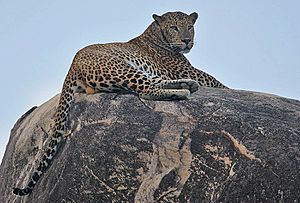
Yala National Park in the southeast protects herds of elephant, deer, and peacocks. The Wilpattu National Park in the northwest, the largest national park, preserves the habitats of many water birds such as storks, pelicans, ibis, and spoonbills. The island has four biosphere reserves: Bundala, Hurulu Forest Reserve, the Kanneliya-Dediyagala-Nakiyadeniya, and Sinharaja. Sinharaja is home to 26 endemic birds and 20 rainforest species, including the elusive red-faced malkoha, the green-billed coucal and the Sri Lanka blue magpie. The untapped genetic potential of Sinharaja flora is enormous. Of the 211 woody trees and lianas within the reserve, 139 (66%) are endemic. The total vegetation density, including trees, shrubs, herbs, and seedlings, has been estimated at 240,000 individuals per hectare. The Minneriya National Park borders the Minneriya Tank, which is an important source of water for elephants inhabiting the surrounding forests. Dubbed "The Gathering", the congregation of elephants can be seen on the tank-bed in the late dry season (August to October) as the surrounding water sources steadily disappear. The park also encompasses a range of micro-habitats which include classic dry zone tropical monsoonal evergreen forest, thick stands of giant bamboo, hilly pastures (patanas), and grasslands (talawas).
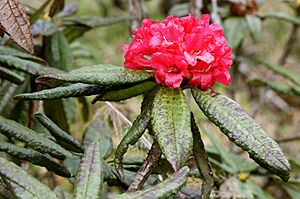
During the Mahaweli Program of the 1970s and 1980s in northern Sri Lanka, the government set aside four areas of land totalling 1,900 km2 (730 sq mi) as national parks. Statistics of Sri Lanka's forest cover show rapid deforestation from 1956 to 2010. In 1956, 44.2 percent of the country's land area had forest cover. Forest cover depleted rapidly in recent decades; 29.6 percent in 1999, 28.7 percent in 2010.
Government and politics
Sri Lanka is a democratic republic and a unitary state which is governed by a semi-presidential system. Sri Lanka is the oldest democracy in Asia. Most provisions of the constitution can be amended by a two-thirds majority in parliament. The amendment of certain fundamental features, including clauses on national symbols, religion, term limits, the reference to Sri Lanka as a unitary state, and the entrenchment mechanism itself, requires both a two-thirds majority in Parliament and approval in a nationwide referendum. The Constitution of Sri Lanka officially declares it to be a socialist state.
In common with many democracies, the Sri Lankan government has three branches:
- Executive: The President of Sri Lanka is the head of state; the commander in chief of the armed forces; chief executive, and is popularly elected for a five-year term. The president heads the cabinet and appoints ministers from elected members of parliament. The president is immune from legal proceedings while in the office with respect to any acts done or omitted to be done by him or her in either an official or private capacity. Following the passage of the 19th amendment to the constitution in 2015, the president has two terms, which previously stood at no term limit.
- Legislative: The Parliament of Sri Lanka is a unicameral 225-member legislature with 196 members elected from 22 multi-seat constituencies and 29 elected by proportional representation. Members are elected by universal suffrage for a five-year term. The president may summon, suspend, or end a legislative session and dissolve Parliament at any time after four and a half years. The parliament reserves the power to make all laws. The president's deputy and head of government, the prime minister, leads the ruling party in parliament and shares many executive responsibilities, mainly in domestic affairs.
- Judicial: Sri Lanka's judiciary consists of a Supreme Court – the highest and final superior court of record, a Court of Appeal, High Courts and a number of subordinate courts. The highly complex legal system reflects diverse cultural influences. Criminal law is based almost entirely on British law. Basic civil law derives from Roman-Dutch law. Laws pertaining to marriage, divorce, and inheritance are communal. Because of ancient customary practices and religion, the Sinhala customary law (Kandyan law), the Thesavalamai, and Sharia law are followed in special cases. The president appoints judges to the Supreme Court, the Court of Appeal, and the High Courts. A judicial service commission, composed of the chief justice and two Supreme Court judges, appoints, transfers, and dismisses lower court judges.
Economy
The country's main economic sectors are tourism, tea export, clothing, rice production, and other agricultural products.
As of 2020[update], the service sector makes up 59.7% of GDP, the industrial sector 26.2%, and the agriculture sector 8.4%. The private sector accounts for 85% of the economy. China, India and the United States are Sri Lanka's largest trading partners.
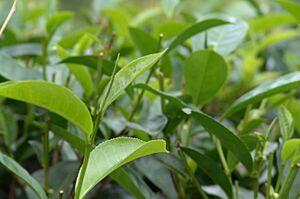
The per capita income of Sri Lanka doubled from 2005 to 2011. During the same period, poverty dropped from 15.2% to 7.6%, unemployment rate dropped from 7.2% to 4.9%, market capitalisation of the Colombo Stock Exchange quadrupled, and the budget deficit doubled. 99% of the households in Sri Lanka are electrified; 93.2% of the population have access to safe drinking water; and 53.1% have access to pipe-borne water. Income inequality has also dropped in recent years.
Languages
Sinhala and Tamil are the two official languages. The constitution defines English as the link language. English is widely used for education, scientific and commercial purposes. Members of the Burgher community speak variant forms of Portuguese Creole and Dutch with varying proficiency, while members of the Malay community speak a form of Creole Malay that is unique to the island.
Religion
Buddhism is practised by 70.2% of the Sri Lankan population. Sri Lanka has the longest continuous history of Buddhism of any predominantly Buddhist nation.
Hinduism was the dominant religion in Sri Lanka before the arrival of Buddhism in the 3rd century BCE. Buddhism was introduced into Sri Lanka by Mahinda, the son of Emperor Ashoka, during the reign of King Devanampiya Tissa; the Sinhalese embraced Buddhism and Tamils remain Hindus in Sri Lanka.
Islam is the third most prevalent religion in the country. Most followers on the island today are Sunni.
Around 7.4% of the Sri Lankan population are Christians, of whom 82% are Roman Catholics.
There is also a small population of Zoroastrian immigrants from India (Parsis).
National symbols of Sri Lanka
Flag
The Sri Lanka flag is also known as the Lion flag because of the Lion on it. The Lion is holding a sword in its right paw. There is a crimson background with four leaves in each corner. There is a yellow border. On the left of the flag there are the colors green and saffron.
The lion represents bravery. The four leaves represents Karuna, Meththa, Muditha and Upeksha. The orange stripe represents the Sri Lankan Tamils and the green stripe represents the Sri Lankan Moors.
Culture
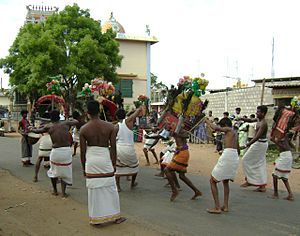
The culture of Sri Lanka is influenced primarily by Buddhism and Hinduism. Sri Lanka is the home to two main traditional cultures: the Sinhalese (centred in Kandy and Anuradhapura) and the Tamil (centred in Jaffna). Tamils co-existed with the Sinhalese people since then, and the early mixing rendered the two ethnic groups almost physically indistinguishable. Ancient Sri Lanka is marked for its genius in hydraulic engineering and architecture. The British colonial culture has also influenced the locals. The rich cultural traditions shared by all Sri Lankan cultures is the basis of the country's long life expectancy, advanced health standards, and high literacy rate.
Food and festivals
Dishes include rice and curry, pittu, kiribath, wholemeal roti, string hoppers, wattalapam (a rich pudding of Malay origin made with coconut milk, jaggery, cashews, eggs, and spices including cinnamon and nutmeg), kottu, and appam. Jackfruit may sometimes replace rice. Traditionally food is served on a plantain leaf or lotus leaf. Middle Eastern influences and practices are found in traditional Moor dishes, while Dutch and Portuguese influences are found with the island's Burgher community preserving their culture through traditional dishes such as lamprais (rice cooked in stock and baked in a banana leaf), breudher (Dutch holiday biscuit), and Bolo fiado (Portuguese-style layer cake).
In April, Sri Lankans celebrate the Buddhist and Hindu new year festivals. Esala Perahera is a symbolic Buddhist festival consisting of dances and decorated elephants held in Kandy in July and August. Fire dances, whip dances, Kandyan dances and various other cultural dances are integral parts of the festival. Christians celebrate Christmas on 25 December to celebrate the birth of Jesus Christ and Easter to celebrate the resurrection of Jesus. Tamils celebrate Thai Pongal and Maha Shivaratri, and Muslims celebrate Hajj and Ramadan.
Visual, literary and performing arts
The movie Kadawunu Poronduwa (The Broken Promise), produced by S. M. Nayagam of Chitra Kala Movietone, heralded the coming of Sri Lankan cinema in 1947. Ranmuthu Duwa (Island of Treasures) marked the transition of cinema from black-and-white to colour. In recent years, movies have featured subjects such as family melodrama, social transformation and the years of conflict between the military and the LTTE. The Sri Lankan cinematic style is similar to Bollywood movies. In 1979, movie attendance rose to an all-time high but has been in a steady decline since then.
An influential filmmaker is Lester James Peiris, who has directed a number of movies which led to global acclaim, including Rekava (Line of Destiny, 1956), Gamperaliya (The Changing Village, 1964), Nidhanaya (The Treasure, 1970) and Golu Hadawatha (Cold Heart, 1968). Sri Lankan-Canadian poet Rienzi Crusz, is the subject of a documentary on his life in Sri Lanka. His work is published in Sinhala and English. Naturalised Canadian Michael Ondaatje is well known for his English-language novels and three films.
The earliest music in Sri Lanka came from theatrical performances such as Kolam, Sokari and Nadagam. Traditional music instruments such as Béra, Thammátama, Daŭla and Răbān were performed at these dramas. The first music album, Nurthi, recorded in 1903, was released through Radio Ceylon. Songwriters like Mahagama Sekara and Ananda Samarakoon and musicians such as W. D. Amaradeva, Victor Ratnayake, Nanda Malini and Clarence Wijewardene have contributed much towards the progression of Sri Lankan music. Baila music originated among Kaffirs or the Afro-Sinhalese community.
There are three main styles of Sri Lankan classical dance. They are, the Kandyan dances, low country dances and Sabaragamuwa dances. Of these, the Kandyan style is most prominent. It is a sophisticated form of dance that consists of five sub-categories: Ves dance, Naiyandi dance, Udekki dance, Pantheru dance and 18 Vannam. An elaborate headdress is worn by the male dancers, and a drum called Geta Béraya is used to assist the dancers to keep on rhythm.
The history of Sri Lankan painting and sculpture can be traced as far back as to the 2nd or 3rd century BCE. The earliest mention about the art of painting on Mahāvaṃsa, is to the drawing of a palace on cloth using cinnabar in the 2nd century BCE. The chronicles have a description of various paintings in relic chambers of Buddhist stupas and in monastic residences.
Theatre came to the country when a Parsi theatre company from Mumbai introduced Nurti, a blend of European and Indian theatrical conventions to the Colombo audience in the 19th century. The golden age of Sri Lankan drama and theatre began with the staging of Maname, a play written by Ediriweera Sarachchandra in 1956. It was followed by a series of popular dramas like Sinhabāhu, Pabāvatī, Mahāsāra, Muudu Puththu and Subha saha Yasa.
Sri Lankan literature spans at least two millennia and is heir to the Aryan literary tradition as embodied in the hymns of the Rigveda. The Pāli Canon, the standard collection of scriptures in the Theravada Buddhist tradition, was written down in Sri Lanka during the Fourth Buddhist council, at the Alulena cave temple, Kegalle, as early as 29 BCE. Chronicles such as the Mahāvaṃsa, written in the 6th century, provide vivid descriptions of Sri Lankan dynasties. According to the German philosopher Wilhelm Geiger, the chronicles are based on Sinhala Atthakatha (commentary). The oldest surviving prose work is the Dhampiya-Atuva-Getapadaya, compiled in the 9th century CE. The greatest literary feats of medieval Sri Lanka include Sandesha Kāvya (poetic messages) such as Girā Sandeshaya (parrot message), Hansa Sandeshaya (swan message) and Salalihini Sandeshaya (myna message). Poetry including Kavsilumina, Kavya-Sekharaya (Diadem of Poetry) and proses such as Saddharma-Ratnāvaliya, Amāvatura (Flood of Nectar) and Pujāvaliya are also notable works of this period, which is considered to be the golden age of Sri Lankan literature. The first modern-day novel, Meena by Simon de Silva appeared in 1905 and was followed by several revolutionary literary works. Martin Wickramasinghe, the author of Madol Doova is considered the iconic figure of Sri Lankan literature.
Sport
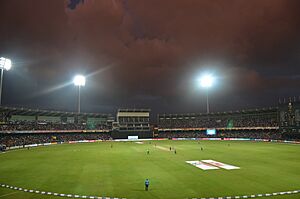
While the national sport is volleyball, by far the most popular sport in the country is Cricket. Rugby union also enjoys extensive popularity, as do association football, netball and tennis. Aquatic sports such as boating, surfing, swimming, kitesurfing and scuba diving attract many Sri Lankans and foreign tourists. There are two styles of martial arts native to Sri Lanka: Cheena di and Angampora.
The Sri Lanka national cricket team achieved considerable success beginning in the 1990s, rising from underdog status to winning the 1996 Cricket World Cup, defeating Australia in the final on 17 March 1996. They also won the 2014 ICC World Twenty20 played in Bangladesh, beating India in the final. In addition, Sri Lanka became the runners-up of the Cricket World Cup in 2007 and 2011, and of the ICC World Twenty20 in 2009 and 2012. Former Sri Lankan off-spinner Muttiah Muralitharan has been rated as the greatest test match bowler ever by Wisden Cricketers' Almanack, and four Sri Lankan cricketers ranked 2nd (Sangakkara), 4th (Jayasuriya), 5th (Jayawardene) and 11th (Dilshan) highest ODI run scorers of all time, which is the second best by a team. As of June 2022, Muttiah Muralitharan has the highest aggregate wickets in Test Cricket with a record 800 wickets, a feat he achieved in a Test Match against India in July 2010 that Sri Lanka had won by 10 Wickets. Sri Lanka has won the Asia Cup in 1986, 1997, 2004, 2008, 2014. and 2022. Sri Lanka once held the highest team score in all three formats of cricket. The country co-hosted the Cricket World Cup in 1996 and 2011 and hosted the 2012 ICC World Twenty20.
Sri Lankans have won two medals at Olympic Games: one silver, by Duncan White at the 1948 London Olympics for men's 400 metres hurdles; and one silver by Susanthika Jayasinghe at the 2000 Sydney Olympics for women's 200 metres. In 1973, Muhammad Lafir won the World Billiards Championship, the highest feat by a Sri Lankan in a Cue sport. Sri Lanka has also won the Carrom World Championship titles twice in 2012, 2016 and 2018, the men's team becoming champions and the women's team winning second place. The Sri Lankan National Badminton Championships was annually held between 1953 and 2011.
Sri Lanka national football team also won the prestigious 1995 South Asian Gold Cup.
Related pages
- List of rivers of Sri Lanka
- Sri Lanka at the Olympics
- Sri Lanka national football team
- Burning of Jaffna library
Images for kids
-
Ptolemy's world map of Ceylon, first century CE, in a 1535 publication
-
A 17th-century engraving of Dutch explorer Joris van Spilbergen meeting with King Vimaladharmasuriya in 1602
-
A 1595 map of Sri Lanka created by Dutch cartographer Petrus Plancius
-
The Sri Lankan elephant is one of three recognised subspecies of the Asian elephant. The 2011 elephant census estimated a population of 5,879.
-
President J. R. Jayewardene gifting a baby elephant to US President Ronald Reagan in 1984
See also
 In Spanish: Sri Lanka para niños
In Spanish: Sri Lanka para niños




